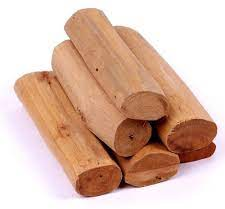Sandalwood Spike Disease | 25 Oct 2022
For Prelims: Sandalwood Spike Disease, Indian Sandalwood, Phytoplasma, Santalum album.
For Mains: Sandalwood Spike Disease and Related Concerns.
Why in News?
Recently, a study showed that Sandalwood Spike Disease (SSD) is posing a severe threat on the Commercial Cultivation of Sandalwood.
What is Sandalwood Spike Disease?
- About:
- It is an infectious disease which is caused by phytoplasma.
- Phytoplasmas are bacterial parasites of plant tissues — which are transmitted by insect vectors and involved in plant-to-plant transmission.
- There is no cure as of now for the infection.
- Presently, there is no option but to cut down and remove the infected tree to prevent the spread of the disease.
- The disease was first reported in Kodagu, Karnataka in 1899.
- More than a million sandalwood trees were removed in the Kodagu and Mysore region between 1903 and 1916.
- It is an infectious disease which is caused by phytoplasma.
- Concerns:
- About 1% to 5% of sandalwood trees are lost every year due to the disease, scientists warn that it could wipe out the entire natural population if measures are not taken to prevent its spread.
- Another concern is, any delay in arresting the trend may result in the disease spreading to cultivated sandalwood trees.
- Recent Steps:
- In an effort to combat the killer disease, the Institute of Wood Science and Technology (IWST), Bangalorel joined hands with the Pune-based National Centre for Cell Sciences for a three-year study, initiated by the Union Ministry of AYUSH with a financial allocation of Rs. 50 lakhs.
- IWST is a Centre of Excellence for Sandalwood Research and Wood Science.
- In an effort to combat the killer disease, the Institute of Wood Science and Technology (IWST), Bangalorel joined hands with the Pune-based National Centre for Cell Sciences for a three-year study, initiated by the Union Ministry of AYUSH with a financial allocation of Rs. 50 lakhs.
What is Indian Sandalwood?
- About:
- Santalum album, commonly known as Indian Sandalwood, is a dry deciduous forest species native to China, India, Indonesia, Australia, and the Philippines.
- Sandalwood has been long associated with the Indian heritage & culture, as the country contributed 85% of the world’ sandalwood trade erstwhile. However, lately this has been declining at a fast rate.
- This small tropical tree grows to 20m high with red wood and a variety of dark colors of bark (dark brown, reddish and dark grey).
- Because it is strong and durable, S. album is mostly harvested for its timber.
- Santalum album, commonly known as Indian Sandalwood, is a dry deciduous forest species native to China, India, Indonesia, Australia, and the Philippines.

- IUCN Red List Status: Vulnerable
- Uses:
- In India, it is also called "Chandan" and "Srigandha". Sandalwood has a special place in Indian tradition where it is being used from cradle to cremation.
- Sandalwood heartwood, which is close-grained, is used for fine furniture and carving. The heartwood and roots also contain ‘sandal oil’ which is valued for use in perfumes, incense, cosmetics, soaps, and medicines. The bark contains tannin, which is used for dye.
- Sandalwood essential oil has antiseptic, anti-inflammatory, antispasmodic and astringent properties.
- It is used in aromatherapy to reduce stress, hypertension and heals wounds and treats skin blemishes.
- Major Growing Areas:
- In India, sandalwood is mostly grown in Andhra Pradesh, Telangana, Bihar, Gujarat, Karnataka, Madhya Pradesh, Maharashtra, and Tamil Nadu.
Way Forward
- The study has recommended accreditation of commercial production of sandalwood seedlings through testing to ensure that the plants are free from SSD.
- It has also called for a paradigm shift in policies handling sandalwood seedlings.
UPSC Civil Services Examination Previous Year Question:
Q. With reference to ‘Red Sanders’, sometimes seen in the news, consider the following statements: (2016)
1. It is a tree species found in a part of South India.
2. It is one of the most important trees in the tropical rain forest areas of South India.
Which of the statements given above is/are correct?
(a) 1 only
(b) 2 only
(c) Both 1 and 2
(d) Neither 1 nor 2
Ans: (a)
Exp:
- Red Sanders has a highly restricted distribution in the southeastern portion of Indian peninsula to which it is endemic. Hence, statement 1 is correct.
- Red Sanders (Pterocarpus santalinus) occurs in the forest formation which is classified as Southern Tropical Dry Deciduous Forests. Hence, statement 2 is not correct.
- The tree is endemic to several districts in Andhra Pradesh and some parts of Tamil Nadu and Karnataka.
- It is known for its rich hue and therapeutic properties. It is high in demand across Asia, particularly in China and Japan, for use in cosmetics and medicinal products as well as for making furniture, woodcraft and musical instruments.
- In the 1980s, the Union government recommended inclusion of Red Sanders in Appendix II of CITES. It was listed in Appendix II of CITES in 1995, and subsequently exports of Red Sanders has been prohibited since 2004.
- Therefore, option (a) is the correct answer.
